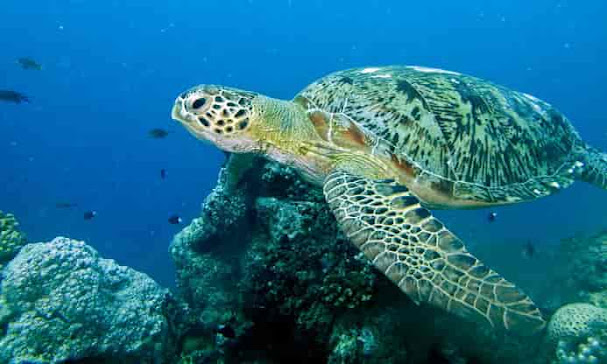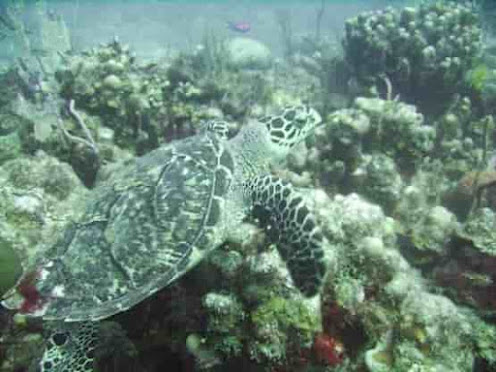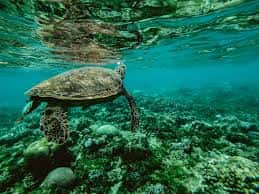Green Sea Turtles Facts

The green sea turtle is also called the green turtle, black turtle or Pacific green turtle. This large species of sea turtle belongs to family Cheloriidae. The scientific name is Chelonia mydas. The green turtle has layer of greenish color fat between their inner organs and its shell so they are called green turtle. Green turtle are found worldwide and has many local names such as “honu” in Hawaiian language. In Hawaii, the green turtle symbolizes good luck and longevity.
Leatherback Turtle/ All About Leatherback Sea Turtle
Description of Green Sea Turtle
Green sea turtle has flattened body, a small blunt
head, smooth heart-shaped shell or carapace, short neck, very short snout and unhooked
beak and four paddle-like arms. The length of adult green turtle is about 5 feet long
and weight will be 190kg. The average length of their carapace is 78 to
112cm. Their neck cannot be pulled into their shells or carapace. They have
strong jaws and very sharp horny beaks. Green turtle’s lower jaw is strong,
serrated. Green turtle has a single pair of prefrontal scale on the dorsal
surface of the head. Its carapace has various color patters from pale to dark
green or dark yellow brown and green with stripes. Their color and patterns of
the carapace change over time with their life cycle. The color of plastron of the
Atlantic population of green turtle is white to yellowish but in the Pacific
population, the color of its plastron is dark grey or bluish green. Green
turtle’s limbs are dark in color and yellow lined on them and all flippers have
claws. Females have longer tails and claws.
Behavior of the Green Sea Turtle
1. Green sea turtle spend most of their lives in shallow coastal water where they can get sea grass. Though they live underwater, but must breathe oxygen from the air. Their lungs allow a rapid exchange of oxygen and prevent gases from being trapped during deep dives. Green sea turtles take rest and also sleep underwater. During the night while sleeping, they hide themselves under the rocks or under the reefs and coral rocks, to protect themselves from predators. Green turtles have good vision and can see many colours but they are most sensitive to light from violet and yellow. Green sea turtles can understand the pattern and shape differences but peripheral vision is absent. Green sea turtles have no external ears but have only ear bones in the middle ear, called “columella”. The sea turtle ossicular system includes the extrocumella and the columella (steps).The middle ear is surrounded by bones and filled with air and connected to the throat with a Eustachian tube. An extension of facial tissue covers their ears which is called the tympanum. They can hear low frequency sounds from 200 to 700Hz. The green sea turtle can feel changes in water pressure that warn then of predators. They have no nostrils but have two openings. There are two sets of sensory cells called the Jacobson’s organ in the nasal passage that help them to smell by pumping water in and out of its nose. Under its chin, green turtle has bumps called “Barbels”. These barbles have nerves that pick up scents. Their sense of smell helps them to avoid predators. Green turtle’s skin is leathery and sensitive. The series of nerves beneath the surface of their carapace enables them to know human touch. When they migrate long distance, they navigate using waves directions, sun light and temperature. The green turtle also has an internal compass and have ability to detect magnetic information through the magnetic crystals in their brain which help them to detect the Earth’s magnetic field. As each part of the coastline has its own magnetic signature, the green sea turtles remember and return to their native beaches where once they were born to mate and lay eggs.
What is the green sea turtles role in
the ecosystem?
Green sea turtles eat sea grass but
trimming only the top without damaging the roots of the plants and that help to
improve the health and growth of the marine vegetation and provide a good
habitat and feeding grounds of many fish and other marine animals.
The yellow tang fish feeds on the
algae, barnacles and parasites on the shell and flippers of the green sea
turtle. In this way the tang fish clean and smooth the turtles shell and the
turtle provides food to the tang fish.
Green Sea Turtle Predators

Human being and the tiger sharks are
the main enemies of the green sea turtles. The tiger sharks hunt and eat the adult
green turtles. Hatchlings and juveniles are eaten by crabs, small marine
mammals and shorebirds. Green sea turtles lay eggs inside the hole on the beach
but are stolen by red foxes and golden jackals. Many parasites attach to green
sea turtle like barnacles, nematodes, leaches, protozoans, cestodes etc.
Leeches stick on the green turtle’s skin and flippers and barnacles stick on
the carapace. These parasites damage the soft tissues and leading to blood
loss. Some parasites like protozoans, nematodes, cestodes are the cause of
liner and internal track infections and many green turtle’s deaths.
Fibropapilloma is the deadly disease
threat to the green turtles. Some parasites, bacteria, environmental
pollutants, UV-light, changing water temperatures and biotoxins are the cause
of Fibropapilloma or FP. Stress and
immunological conditions appear to be related to FP. FP is mainly occurs in warmer
waters around the tropics. FP is the most significant infectious disease threat
affects the sea turtles worldwide.
FP produces giant tumors which are 1 cm to more than 30 cm in diameter, on the green
turtle’s mouth, eyelids, flippers, skin, shell and also their internal organs
like in heart, lungs and kidneys. FP is most common among immature and juvenile
green turtles but rare in adult turtles.
The leech genus Ozobranchus is
considered a mechanical vector of herpesvirus, which transports the virus from
one turtle to another.
The two toxins, Lyngbyatoxin and okadaic acid are likely to be
associated with FP are epiphytically found on the plants which are eaten by
green sea turtles.
The infected green turtles with large
numbers of tumors become anemic, have a lack of proteins and iron, suffer from acidosis and extreme weight loss.
Green Sea Turtle Diet

Green turtle is omnivores but adults
eat only plants so they can be called herbivores. The adult turtles eat sea
grasses, seaweed, algae. Green turtles have serrated beaks that help them to
tear grasses and seaweeds and also scrape algae off rocks. Juvenile green
turtles eat invertebrates like crabs, sponges, and jellyfish.
Green Sea Turtle Habitat

Green sea turtles are found in over
80 countries and live in warm subtropical and tropical ocean waters. In the
United States, Green sea turtles are found on the Hawaiian Islands, Puerto Rico,
the Virgin Islands and the east coast of Florida. They are also found on
Atlantic coast in Georgia, South California and North Carolina.
Green sea turtles live in the
Atlantic Oceans, Indian Ocean and Pacific Oceans. Atlantic green sea turtles
are normally found near the shores of Europe and North America but the Easter
Pacific green turtles are found in the shallow water from Alaska to Chile.
Green sea turtles spend most time in
the coastal waters, where they get sea grass. They are also found in coral
reefs, where they get red, brown and green algae to eat and also get protection
from predators and rough storms. The Green sea turtles migrate a long distance
from their feeding grounds to hatching beaches.
In Indian Ocean, Green sea turtles
live in India, Pakistan, Sri Lanka and other coastal countries. The coastal
areas of the Africa continent are also the nesting ground of the green sea
turtles.
Green Sea Turtle Reproduction

Green tortoises are sexually mature
at the age of 25 to 35 years. Female green
sea turtle lays eggs on their native beaches, 3 to 5 times per season and an
average of 115 eggs in each nest. The eggs incubate for 6o days and hatchings
make their way to the water. The female turtles travel a long distance to reach
their native beaches where once they were born to lay eggs. It digs a hole on
the sandy beach and lays eggs in the hole and then covers the hole with sand.
Now it leaves the nesting ground. The temperature
in the nest affects the sex-determination. The temperature of the nesting sites
is above 30 degree Celsius favor the development of females and below 30 degree
Celsius produce males.
Why are Green Sea Turtles Endangered?
Green sea turtle is listed as
endangered or threatened. Their numbers are declined because of hunting and poaching
for their shells, eggs, skin and meat. There are many reasons for decline their
numbers.
·
Rising sea level due to climate
change, severity of storm submerges some nesting beaches. Shoreline hardening
can result in the complete loss of dry sand suitable for successful nesting. Climate change affects the sand temperatures on the
nesting ground which then affects the sex of hatchlings.
·
Many green turtles are unintendedly
caught in shrimp trawl net, longline hooks, fishing gill-nets, fishing gear.
The turtles swallow the fishing hooks that cause internal injuries and lead
them to death. Every year about 4600 sea turtles are killed due to fishing.
·
Coastal development, vehicle traffic
on beaches, and other human activities destroy or disturbed Green sea turtle
nesting beaches around the world.
·
Water pollutants, oil spills harmful
chemicals from the factories and power plants are the poisonous for all sea
turtles.
· Many people around the world consume the turtle meat and eggs and also sell these to earn money. They are hunted and killed for religious ceremonies and medicine. Turtle’s populations have reduced in the past few decades due to human’s demand for their meat, skin, eggs and shells.
·
Light pollution in the coastal region
is considered one of the main causes of significant threat to sea turtles. Artificial lighting along the coast can confuse and
misdirect the hatchlings, increasing their risk of death by predators.
Protect Sea
Turtle Habitat
·
Reduce marine debris
·
Use biodegradable things like reusable water bottles and shopping bags
·
Reduce turtle bycatch and switch to
more turtle-friendly fishing hooks.
· Manage artificial light around the beach and Keep the nesting beaches dark and safe for sea turtles.
What are 5 interesting facts about Green sea turtles?
1. Green turtles can keep their breath
underwater for five hours.
2. In Hawaii, the green turtle
symbolizes good luck and longevity.
3. Green sea turtle ear is covered by an
extension of facial tissue called the tympanum. They can hear low frequency
sounds from 200 to 700Hz.
4. It digs a hole on the sandy beach and
lays eggs in the hole and the temperature of the nesting sites is above 30
degree Celsius favor the development of females and below 30 degree Celsius
produce males.
5. Green sea turtle has an internal compass and have ability to detect magnetic information through the magnetic crystals in their brain which help them to detect the Earth’s magnetic field.
How fast do green sea turtles swim?
Green sea
turtles typically swim at a speed of 2.53 km / h (1.6–1.9 mph) but their
swimming speed can reach up to 35km/h when they are threatened. Green sea turtle are super-strong
swimmers. Their strong paddle-like flippers help them to swim from their
feeding grounds to their mating-nesting sites. Long distances of more than 2,600 kilometres have been
recorded.
What eats a green sea turtle?
Green turtle
is omnivores. They eat sea grasses, seaweed, algae. Juvenile green turtles eat
invertebrates like crabs, sponges, and jellyfish. They are found in coral reefs, where
they get red, brown and green algae to eat.
Where do green sea turtles sleep?
Green sea
turtles feed and rest during the day. During the night while sleeping, they hide themselves under
the rocks or under the reefs and coral rocks, to protect themselves from
predators. Many divers
noticed that the green turtles were sleeping under ledges in reefs and rocks. Hatchlings usually sleep while
floating on the surface.
How many eggs do green sea turtles
lay?
The female
turtle dig a hole on the beach sand. They constructed this body pit with their
flippers and rotating her body. Then she starts to lay eggs. Two or three eggs
come out at a time, in which mucus is secreted during laying the whole egg.
Female green sea turtle lays a
clutch of about 115 eggs.
Why green sea turtles are called
green?
Adult green
turtles are herbivores. They eat only plants such as sea grasses and algae.
The green turtle has layer of
greenish color fat between their inner organs and its shell so they are called
green turtle.


.jpg)














0 Comentarios:
Post a Comment
Please do not use any abusing words or enter any spam links in the comment box